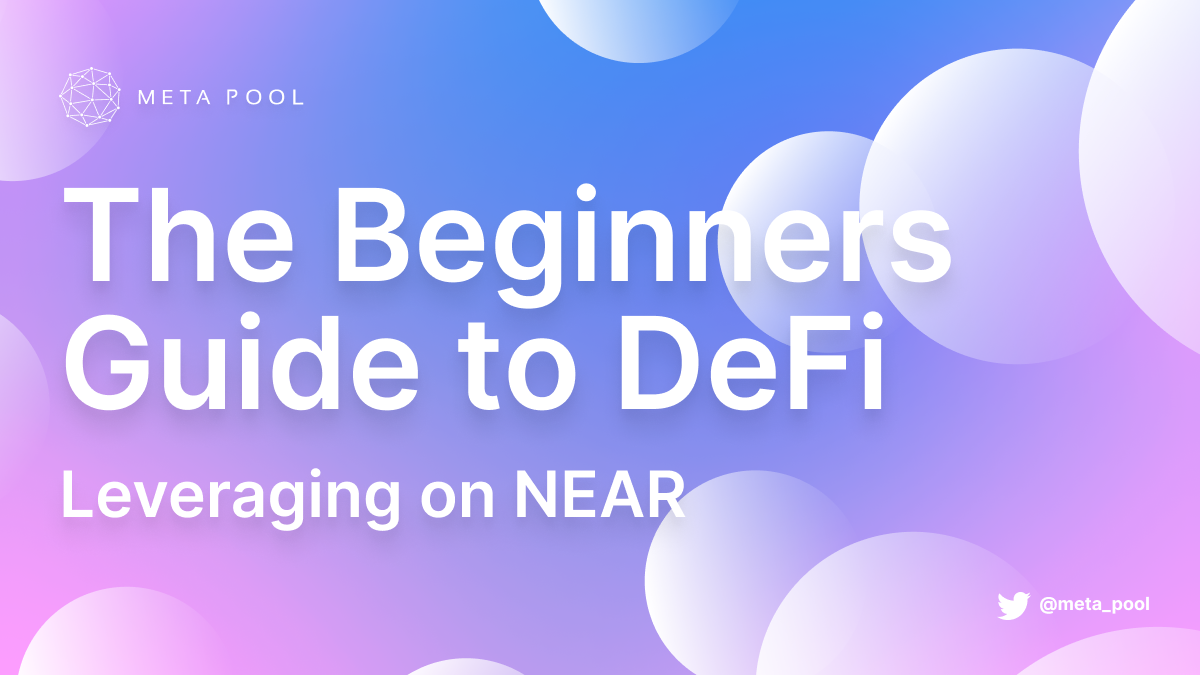TL;DR
- Beginners Guide to DeFi: Leveraging on NEAR Protocol
- stNEAR (‘Staked NEAR’) is a staking yield bearing asset on NEAR which allows you to access liquidity while earning staking rewards.
- Access liquidity by using stNEAR as collateral on Lending Platforms
- Borrow Stablecoins against stNEAR
- Platforms to leverage on NEAR native: OIN and Burrow. Aurigami
- Platforms to leverage on on Aurora: Bastion, and Rose
- More platforms launching soon!
Leveraging in DeFi
In the DeFi space, there are endless possibilities for leveraging. The goal is to take advantage of different offerings and yields across platforms, also known as stacking. Borrow funds from these DeFi platforms and reinvest them in order to get a better return than the cost of the loan.
We will cover different leveraging strategies that use stNEAR in future articles.
Liquidity Protocol in DeFi in a Nutshell
In traditional finance, people deposit money they don’t intend to use and collect interest from institutions such as banks. This money is used by the bank to offer financial services and to lend to those who are in need.
In order to get a secured loan, the borrower normally has to put up some kind of collateral, an asset that can be liquidated by the bank to pay back the loan in case the borrower defaults on their obligations. The borrower uses money to generate revenue and repay the debt with some fee. Something similar happens with Decentralized Finance (DeFi).

In DeFi, smart contracts – lines of code that execute automatically only when certain criteria is met – replace the bank as an intermediary.
Lenders deposit their assets into the smart contract in a trustless manner – contract has a limited range of functions that can’t be altered – acting as the provider of loans in exchange for interest rates and often additional incentive rewards.
The borrower can take out loans by depositing their collateral assets (cryptocurrencies) and borrow from the protocol using the liquidity given in the pool.
In some platforms, the borrowers are also incentivized by the platform’s token to take out a loan.
At a later stage, when the borrowers repay the debt in full, the underlying assets are unlocked and can be redeemed to the borrower back into their wallet with some loan fee to the platform.
On the liquidity protocols, users can lend and borrow funds in a completely decentralized and permissionless manner. This entire process of depositing, borrowing, repaying, collecting fees, and withdrawing funds can be completed without the need of any intermediaries but only smart contracts. Most importantly, users maintain full custody over their funds.
Lending on DeFi
Lending is on the liquidity supply side. Lenders can supply assets to the protocol in order to earn interests. Burrow, Bastion and Aurigami are liquidity protocols that allow you to participate in supplying liquidity.
These platforms’ interest rates are flexible and dependent on the asset’s utilization rate.
Lenders will receive the better interest rates when utilization of the asset is high, but this might limit fund withdrawal if the utilization rate reaches 100%. You can check the APY payout on their DApp.
Remember that if you deposit stNEAR with Burrow, you’ll get APY from both lending and staking.
Borrowing on DeFi
On the other side of Liquidity, borrowers can take loans against their collateralized assets.
To mitigate non-performing loans (NPL), the loans will be overcollateralized. The borrower must maintain the value of their collateral, and if it falls below the minimum collateral ratio, it will be liquidated to pay off their debt. As a result, if the collateralized assets provided are volatile, consumers must exercise caution.
To mitigate and safely leverage the liquidation risk, all users must have a thorough understanding of it. The liquidation policy may differ from DApp to DApp, and users must read through their documents.
The Future is NEAR
Beside the 3 distinctive platforms which now live on NEAR Protocol. There will be more to come On-Boarding Lending Protocol NEAR. Burrow, NEXON, Bastion and Flappy are on Testnet.
The lending and borrowing protocol collectively help the NEAR ecosystem to grow faster, matching the need for liquidity to the excess liquidity holders.
Stay tuned for the next era of NEAR protocol with us.
About Meta Pool & stNEAR
Meta Pool is the leading liquid staking solution for $NEAR and wNEAR token holders. With Meta Pool you earn NEAR staking rewards and maintain your liquidity to participate in DeFi protocols on NEAR and Aurora.
Users staking $NEAR and wNEAR with Meta Pool receive in exchange stNEAR (staked NEAR) tokens.
stNEAR simultaneously accrues staking rewards and unlocks users’ liquidity enabling them to participate in DeFi activities (e.g. lending, farming, borrowing) on NEAR and Aurora.
Stake $NEAR on Meta Pool
~10% APY
Get stNEAR
Yield-bearing token
Go DeFi on NEAR & Aurora
More APY and more rewards
Meta Pool also solves the problems associated with Proof-of-Stake networks staking: illiquidity, immovability and accessibility. Meta Pool also aims to distribute staking in multiple validators to improve censorship-resistance of the NEAR network.
With a TVL of ~9 Million $NEAR and growing, Meta Pool has become in just a few months a cornerstone element of the NEAR ecosystem. Meta Pool is making NEAR Protocol more decentralized and therefore more secure.
In February 2022 Meta Pool has been successfully audited by BlockSec, confirming the implementation of the highest security standards.
For more information visit https://metapool.app.
Join Meta Pool & stNEAR Community
If you have any questions or wish to be part of our project, don’t hesitate to join our official platforms and reach out to the team!



Leave a Reply